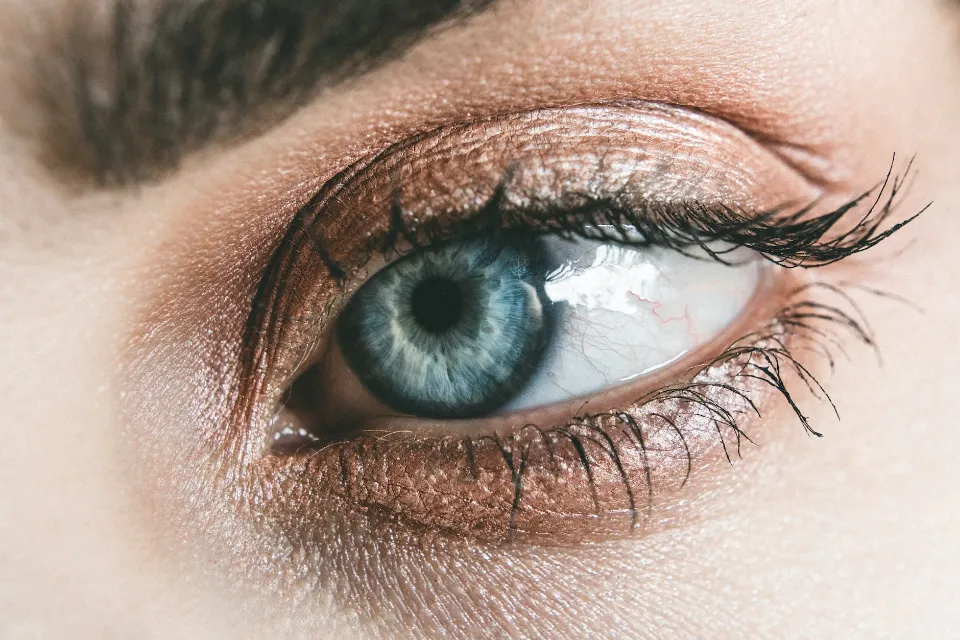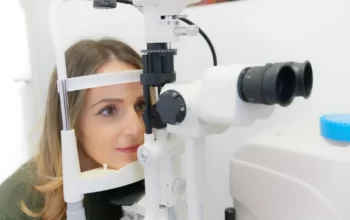
When our eyes are at ease and in good shape, we can concentrate on how the world affects us rather than how our eyes themselves affect us. But it’s challenging to ignore eye discomfort once we experience it. Eye symptoms can disrupt our day, from burning eyes to twitching eyelids. When we blink, it hurts, which is a symptom that needs our attention.
The average person blinks between 900–1,200 times an hour, with each blink lasting between 0.1–0.4 seconds. That amounts to 10% of your awake time. When you blink, it can be very distracting and uncomfortable if your eyes ache.
Eye pain can be caused by a variety of eye disorders and diseases. But dry eyes are a frequent reason for blinking annoyance.
What Causes Eye Blinking Pain?

It is common for debris, such as dirt or sand, to get caught in the eye and cause pain when blinking. It can also be brought on by a sickness or injury, though.
Causes of pain while blinking include:
1. Injury
The eye is comparatively prone to injury. When blinking, pain from acute trauma or debris can hurt the eye or the eye socket.
Scratches to the surface of the eye (the cornea) are a common type of injury that can easily occur from rubbing or touching the eye.
It is also possible for the eye to sustain a burn from overexposure to ultraviolet light from the sun or from contact with certain substances.
There are three types of chemical burns that can occur:
- Alkali burns: Cleaning supplies that contain ammonia, caustic soda, or lime frequently result in this most serious type of burn.
- Acid burns: These can be brought on by vinegar or specific types of polish that contain hydrofluoric acid and are not as severe as alkali burns.
- Irritants: Irritants rarely damage the eye, but can be uncomfortable. Detergents or pepper spray may be the cause.
2. Conjunctivitis
When the transparent membrane that covers the eye and the inside of the eyelid becomes inflamed, it is referred to as conjunctivitis.
Blood vessels can become swollen, making the white parts of the eye red and sore.
Infections or allergies, such as hay fever or a pet allergy, are the root of the condition. It’s contagious to have conjunctivitis brought on by an infection.
3. Stye
When you blink, eye pain from dry eyes, a stye, or pink eye (conjunctivitis) are common causes. Stye and conjunctivitis are both easy to observe on an eye and can appear as suddenly as painful blinking.
When the oil glands or eyelash follicles become infected, it results in a stye. When you blink, the swelling on your eyelids may hurt.
The bacteria that caused the stye is transferable, even though the stye itself is not contagious.
Most styes are caused by bacteria such as Staphylococcus aureus (a “staph” infection), which can spread to others through close contact.
4. Tear Duct Infection
The tear duct can become infected by bacteria if it is blocked, for example, by debris in the eye. When blinking, this may result in pain in the corner of the eye.
5. Blepharitis
Blepharitis is a condition where the edges of the upper or lower eyelids become inflamed. When blinking, the eyelids may grow tender and hurt.
Bacteria, a clogged gland, or specific skin conditions like seborrheic dermatitis can all contribute to the condition.
6. Corneal Ulcer
On the surface of the eye, an open sore known as a corneal ulcer can appear. They typically result from an infection, but they can also arise from wounds like burns or scratches.
7. Sinusitis
Sinuses are small cavities around the eyes and nose. When the sinuses inflame, it is known as sinusitis. Viral infections are most frequently to blame.
This may result in discomfort while blinking, a blocked nose, facial sensitivity, a headache, and other flu-like symptoms.
8. Optic Neuritis
Optic neuritis is brought on by an inflamed optic nerve, which interferes with the brain’s ability to receive visual information from the eye.
This inflammation can cause pain when the eyes or eyelids move.
Additionally, it may impair your ability to properly see colors and temporarily impair your vision.
9. Dry Eye Syndrome
Tear production is hampered in dry eye syndrome, also referred to as dry eye disease. This causes the eyes to become dry and irritated. It might be a source of discomfort when blinking.
10. Graves’ Disease
Graves’ disease is an autoimmune condition that causes the thyroid to overproduce antibodies that mistakenly attack the body. Hyperthyroidism or an overactive thyroid are other names for it.
It might hurt to blink if there is inflammation in and around the eyes.
Other symptoms include anxiety, hyperactivity, itchiness, mood swings, problems sleeping, and persistent thirst.
11. Keratitis
A corneal infection from bacteria or a virus is referred to as keratitis. The symptoms of this infection include discomfort, a gritty or sandy sensation in the eye, and light sensitivity.
Other Notable Symptoms
In addition to your eyes hurting when you blink, you may also experience commonly related symptoms:
- Pain when moving eyes
- Eye pressure
- Inflammation
- Light sensitivity
- Tenderness around eyes (sinuses)
An eye emergency necessitates immediate care if you feel excruciating pain or experience sudden changes in your vision. For an urgent appointment, call us.
However, if the symptoms are tolerable but uncomfortable, you should still book an appointment as soon as possible. After that, we can assess your eye health and create a specialized treatment plan for your symptoms.
How Blinking Works
To maintain the health of our eyes, blinking removes dirt, disperses moisture, and transports oxygen. Eye health can be seriously harmed when our blinking rate is slowed down or our blinks’ quality is compromised. For a tear film to form, our eyes need to blink 900–1,200 times per hour to spread moisture.
The tear film protects, moisturizes, and maintains the eye’s surface. The tear film is made of 3 layers:
- Inner mucus layer
- Middle watery layer
- Outer oily layer
Each layer plays a role in maintaining tear quality and quantity. Our eyes are shielded by tears, which also stop the surface from drying out. When tear production is interrupted, it can hinder our eyelids from spreading moisture, resulting in dry eye.
How Dry Eye Affects Blinking
Poor tear quality, linked to deficiencies in the three tear layers, is the root cause of the condition known as dry eye. Tear production can be affected by multiple factors, including:
- Aging
- UV exposure
- Environmental conditions
- General health problems
- Digital eye strain
- Medications
- Contact lens use
Sensitivity to motion can be brought on by dry spots on the cornea in people with dry eyes. Because their eyes lack lubrication, blinking can become uncomfortable and even painful.
Other symptoms of dry eye include:
- Gritty/scratchy eyes
- Watery eyes
- Fluctuating vision
- Burning eyes
- Feeling something in the eye
Chronic dry eyes are common. However, the condition can be controlled to preserve clear vision and lessen symptoms, such as discomfort when blinking.
Digital Eye Strain & Blinking
Digital eye strain, also known as computer vision syndrome, is one condition that is frequently linked to dry eyes. We blink almost 50% less per minute when we use digital screens. With our decreased blink rate, we are unable to effectively support the tear film. As a result, we experience dry eyes.
In addition to dry eyes, digital eye strain symptoms include:
- Eye strain
- Headaches
- Excessive squinting
- Watery eyes
- Blurry vision
- Eye irritation
Temporary symptoms could be brought on by digital screens. In the majority of cases, limiting screen time can aid in symptom relief. After using a computer, you can try the 20-20-20 rule or artificial tears to hydrate your eyes.
However, repeated and prolonged exposure will make the symptoms worse. Therefore, it’s crucial to visit an optometrist if you experience symptoms of digital eye strain. If there is a serious vision issue, we can assess your eye health to figure out what is causing it.
Relieving Blinking Discomfort
Beginning with a diagnosis, eye pain can be treated. Our eye care specialists can assist you in determining the root of your blinking issue. Your optometrist will examine your eyes and inquire about your lifestyle and surrounding conditions. We can make a treatment recommendation after learning more about your eye health.
If dry eye is the underlying problem, we will suggest various dry eye treatment options. Your eye health, level of comfort, and way of life will all influence the kind of treatment we advise.
Some treatment options include:
- Artificial tears
- Eyelid hygiene
- Medicated eye drops
- Gels or ointments
- Punctal plugs
- Nutrition changes
- Medication (oral)
- Warm compresses
- Radiofrequency (RF) therapy
- Intense Pulsed Light (IPL) therapy
Some Diseases and Conditions Cause Painful Blinking
Other than inflammation, some illnesses impair blinking or at least make it uncomfortable or painful. The majority, but not all, start in the eye.
- Dry eye disease (or syndrome) interferes with tear production. Blinking without tears will hurt because that is what the blinking process is for.
- Graves disease is an autoimmune disease caused by an overactive thyroid that produces too much hormone. Some Graves patients have swollen eyes and inflammation, which makes blinking uncomfortable.
- Keratitis is caused by a viral or bacterial infection in the eye that makes the surface feel gritty; blinking does not ease the feeling.
- A corneal ulcer can develop after a scratch or infection on the eye surface. It can be very uncomfortable to blink on them.
Nearly all ailments that cause painful blinking are curable, or at the very least, manageable. For more information on eye conditions, diseases, symptoms, and treatments, as well as how to avoid eye injury and disease, visit our blog and website.
When Should I Be Concerned About Eye Pain?

Any of the conditions outlined above can progress to the point where you need to see an eye doctor in order to find some relief. You’ll probably need medical attention if you have a corneal ulcer, corneal abrasion, GPC, or conjunctivitis, in particular. In addition, there are certain cases in which you should go to your nearest emergency room to be evaluated by a doctor. These complications include:
- Severe ocular trauma
- Foreign body such as glass or metal
- Sudden, severe pain that does not subside
- Pain that causes new vision problems
- Blood in the eye
- Protruding eyeball
Wrapping Up
The discussion above can be easily concluded by saying that the eyes are the most important organ in the body and that one should take good care of them and take corrective action as soon as pain or any other issue with them is noticed.



